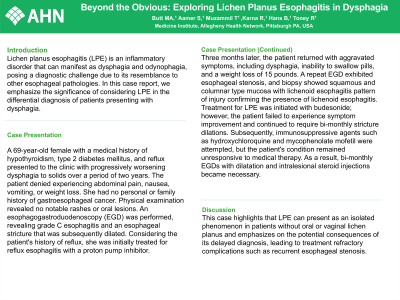Sunday Poster Session
Category: Esophagus
P0496 - Beyond the Obvious: Exploring Lichen Planus Esophagitis in Dysphagia Diagnosis
Sunday, October 22, 2023
3:30 PM - 7:00 PM PT
Location: Exhibit Hall

Has Audio

Muhammad Ali Butt, MD
Medicine Institute, Allegheny Health Network
Pittsburgh, Pennsylvania
Presenting Author(s)
Muhammad Ali Butt, MD1, Sameen Aamer, MD2, Taimur S. Muzammil, MD3, Rahul Karna, MD3, Bandhul Hans, MD4, Rachel Toney, MD3
1Medicine Institute, Allegheny Health Network, Pittsburgh, PA; 2Allegheny General Hospital, Pittsburgh, PA; 3Allegheny Health Network, Pittsburgh, PA; 4University of Texas Medical Branch, Galveston, TX
Introduction: Lichen planus esophagitis (LPE) is an inflammatory disorder that can manifest as dysphagia and odynophagia, posing a diagnostic challenge due to its resemblance to other esophageal pathologies. In this case report, we emphasize the significance of considering LPE in the differential diagnosis of patients presenting with dysphagia.
Case Description/Methods: A 69-year-old female with a medical history of hypothyroidism, type 2 diabetes mellitus, and reflux presented to the clinic with progressively worsening dysphagia to solids over a period of two years. The patient denied experiencing abdominal pain, nausea, vomiting, or weight loss. She had no personal or family history of gastroesophageal cancer. Physical examination revealed no notable rashes or oral lesions. An esophagogastroduodenoscopy (EGD) was performed, revealing grade C esophagitis and an esophageal stricture that was subsequently dilated. Considering the patient's history of reflux, she was initially treated for reflux esophagitis with a proton pump inhibitor.
Three months later, the patient returned with aggravated symptoms, including dysphagia, inability to swallow pills, and a weight loss of 15 pounds. A repeat EGD exhibited esophageal stenosis, and biopsy showed squamous and columnar type mucosa with lichenoid esophagitis pattern of injury confirming the presence of lichenoid esophagitis. Treatment for LPE was initiated with budesonide; however, the patient failed to experience symptom improvement and continued to require bi-monthly stricture dilations. Subsequently, immunosuppressive agents such as hydroxychloroquine and mycophenolate mofetil were attempted, but the patient's condition remained unresponsive to medical therapy. As a result, bi-monthly EGDs with dilatation and intralesional steroid injections became necessary.
Discussion: This case highlights that LPE can present as an isolated phenomenon in patients without oral or vaginal lichen planus and emphasizes on the potential consequences of its delayed diagnosis, leading to treatment refractory complications such as recurrent esophageal stenosis.
Disclosures:
Muhammad Ali Butt, MD1, Sameen Aamer, MD2, Taimur S. Muzammil, MD3, Rahul Karna, MD3, Bandhul Hans, MD4, Rachel Toney, MD3. P0496 - Beyond the Obvious: Exploring Lichen Planus Esophagitis in Dysphagia Diagnosis, ACG 2023 Annual Scientific Meeting Abstracts. Vancouver, BC, Canada: American College of Gastroenterology.
1Medicine Institute, Allegheny Health Network, Pittsburgh, PA; 2Allegheny General Hospital, Pittsburgh, PA; 3Allegheny Health Network, Pittsburgh, PA; 4University of Texas Medical Branch, Galveston, TX
Introduction: Lichen planus esophagitis (LPE) is an inflammatory disorder that can manifest as dysphagia and odynophagia, posing a diagnostic challenge due to its resemblance to other esophageal pathologies. In this case report, we emphasize the significance of considering LPE in the differential diagnosis of patients presenting with dysphagia.
Case Description/Methods: A 69-year-old female with a medical history of hypothyroidism, type 2 diabetes mellitus, and reflux presented to the clinic with progressively worsening dysphagia to solids over a period of two years. The patient denied experiencing abdominal pain, nausea, vomiting, or weight loss. She had no personal or family history of gastroesophageal cancer. Physical examination revealed no notable rashes or oral lesions. An esophagogastroduodenoscopy (EGD) was performed, revealing grade C esophagitis and an esophageal stricture that was subsequently dilated. Considering the patient's history of reflux, she was initially treated for reflux esophagitis with a proton pump inhibitor.
Three months later, the patient returned with aggravated symptoms, including dysphagia, inability to swallow pills, and a weight loss of 15 pounds. A repeat EGD exhibited esophageal stenosis, and biopsy showed squamous and columnar type mucosa with lichenoid esophagitis pattern of injury confirming the presence of lichenoid esophagitis. Treatment for LPE was initiated with budesonide; however, the patient failed to experience symptom improvement and continued to require bi-monthly stricture dilations. Subsequently, immunosuppressive agents such as hydroxychloroquine and mycophenolate mofetil were attempted, but the patient's condition remained unresponsive to medical therapy. As a result, bi-monthly EGDs with dilatation and intralesional steroid injections became necessary.
Discussion: This case highlights that LPE can present as an isolated phenomenon in patients without oral or vaginal lichen planus and emphasizes on the potential consequences of its delayed diagnosis, leading to treatment refractory complications such as recurrent esophageal stenosis.
Disclosures:
Muhammad Ali Butt indicated no relevant financial relationships.
Sameen Aamer indicated no relevant financial relationships.
Taimur Muzammil indicated no relevant financial relationships.
Rahul Karna indicated no relevant financial relationships.
Bandhul Hans indicated no relevant financial relationships.
Rachel Toney indicated no relevant financial relationships.
Muhammad Ali Butt, MD1, Sameen Aamer, MD2, Taimur S. Muzammil, MD3, Rahul Karna, MD3, Bandhul Hans, MD4, Rachel Toney, MD3. P0496 - Beyond the Obvious: Exploring Lichen Planus Esophagitis in Dysphagia Diagnosis, ACG 2023 Annual Scientific Meeting Abstracts. Vancouver, BC, Canada: American College of Gastroenterology.
